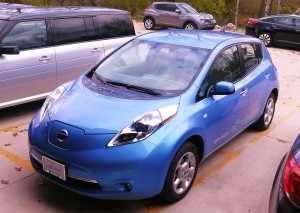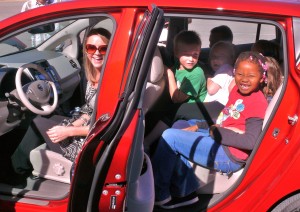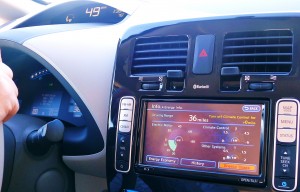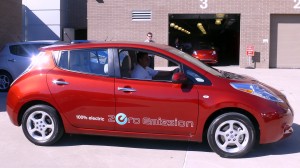Leaf promises green future for Nissan
NASHVILLE, TENN. — It is inevitable, apparently, that while some of us remain loyal to the contemporary sophistication of internal combustion gasoline and/or diesel engines, our cars of the future will be powered by electrical energy. The Nissan Leaf doesn’t promise to jolt us with the future being already here, but it will be on U.S. roadways by the first of the year 2011.
The Leaf is a pure, plug-in electric vehicle, which will reach showrooms by December of 2010 in seven Western and Southwestern states, and its spread through the rest of the country is as inevitable as the morning light. Or, at least the light from a plug-in lamp. Those of us in the Upper Midwest could buy a Leaf as soon as it’s available and make it work just fine, it’s just that Nissan has worked with those specific entry regions to coordinate things, including such elements as an infrastructure of recharging stations.
Nissan’s all-electric Leaf has no coordinated gasoline engine, as in hybrids, and no gasoline engine to come on after the battery pack is drained to keep you running, as in the newly introduced Chevrolet Volt. There is just plug-it-in-and-go electricity powering the Leaf, which has allowed Nissan to boast that it is the first affordable all-electric vehicle. The Chevrolet Volt is impressive, but will find resistance among buyers who wouldn’t mind electrifying their driving, but might balk at $43,000. The Leaf, Nissan says, will be more like $25,280, although that is after a $7,500 federal tax incentive for emission-free vehicles. First drives of the Leaf are impressive, and a little eerie.
How impressive? I drove one on a rural two-lane, deserted enough for me to stop still. It was silent. And when I stepped on the gas pedal — which, come to think of it, will need to be renamed in this car — the Leaf shot from a standing start to 85 miles per hour smoothly and swiftly. At the full media introduction in late October near Nissan headquarters in Nashville, my driving partner was more daring, choosing a stretch of freeway to hit the pedal and accelerate hard. I glanced over and saw the digital speedometer reporting 94 miles per hour.
How eerie? It does all those things, from accelerating hard, to passing cars on the freeway at 94 mph, in absolute silence. Electric power is awesome, compared to gasoline engines, and you have to pay attention to how swiftly trees and roadside signs are rushing past to appreciate how fast you’re going because you get no external feedback unless you are keenly attuned to the subdued wind noise from the air rushing past and around its aerodynamic form. The Leaf resembles a design exercise on a car about the size of the Versa, with a sleeker nose, of course, because it doesn’t have to bulge up in order to house a gasoline engine.
Maybe the best example of the difference came when we stopped for a driver change, by design, at a small-town elementary school, where we were immediately surrounded by Bethany Wiseman’s flock of second-graders. Remember second grade, or at least second-graders? Remember how they can create spontaneous, simultaneous noise that rises to the definition of the word ‘din,’ and never subsides? One of the favorite things any second-grader enjoys is to mimic the sound of a car — “rrrrrrRRR,” followed by a hesitation for a shift-point, during which a lowered voice represents the next gear, continuing to build again: “rrrrrrrRRRRRR…” And so on, depending on whether you’re mimicking a five-speed or six-speed. One inquisitive kid asked me how the Leaf went, and when I told him it accelerated without any sound, he said, “You mean it goes ‘rrrrrr-rrrrr-rrr?” And I said, “No, it makes no noise. Nothing.” Three or four times I repeated that, and, in what would have made priceless advertising footage for Nissan, three or four times the young lad lowered his voice to a softer “rrrrr” sound, approaching the silence I had suggested. Second-graders don’t easily identify with silence, but finally I convinced him by saying, “No, as the Leaf goes faster and faster, it makes about the same sound you would make with a flashlight.”
That did it, although the puzzled look never left his face. How much fun is it for a second-grader to mimic absolute silence? About then, the group returned to being a yowling, chattering mass, as these second-graders tried to see how many second-graders could fit into the back seat of a subcompact four-door. Built to accommodate three back there, the Leaf was quickly overfilled from one side, so a few enterprising kids ran around to the other side, thinking that they could still fit in from there. At one point, we had eight kids in the rear seat, although there was no chance to close the doors. We compromised at five, which would have been a nice carfull to take on a road trip — for Ms. Wiseman, who is a candidate for sainthood, rather than you or me.
Back to school, kids, because we had to hit the road again, where we, as adult automotive journalists were having almost as much difficulty as the kids in accepting the Leaf’s performance.
Flick the little gearshift-thingy — called a “prindle” — on the console into drive, and the Leaf takes off with barely a whir. It handles with nearly sports-car agility, and stops and steers just as well. The prindle allows selection of reverse, neutral or drive, operating more like a computer mouse than a gearshift. A digital speedometer number atop the instrument panel shows how fast you’re going, with a small graph on the upper left showing a fir tree, and more fir trees form to indicate how well, or at least how green, you’re driving. Below, in the main instrumentand bezel, a series of little circular LEDs sweep in an arc across the upper edge, indicating energy use, with full power to the right, energy use in the middle, and regenerative power — such as charging from the brakes — on the left. You can switch into “Eco” mode, which increases pedal pressure to make it harder to accelerate, which can increase your range by 10 percent. If you stomp on it, the pedal overrides the Eco.
Technically, the undercarriage of the Leaf houses a lithium-ion battery pack, which Nissan developed in partnership with NEC. Larry Dominique, Nissan’s vice president of product development, said he believes the Leaf’s battery technology is second to none. The flat, slim lithium-ion battery packs are structured 48 to a module, and four modules laminated into a cell. That allows the entire battery unit to be placed low, for a favorable center of gravity, and to not intrude on the five-passenger occupancy. The battery warranty is for 8 years, or 100,000 miles.
It has a 100-mile range on a full charge, but the mileage can be lower, if you accelerate hard, or if you use the air-conditioning on full all the time. To offset that, the navigation screen readout has range-management tips, showing the remaining miles you can go on your battery power, and suggesting shutting down the climate control for a few minutes to prolong it.
The comparisons with the Chevy Volt will be inevitable. The Volt will go 40-50 miles on a full battery charge, and if it’s drained, a small gasoline engine comes on to get you to your destination — although it will not recharge the battery pack, which requires overnight plug-in charging. Chevrolet says that the majority of people live within 20 miles of work, so they could make it to work and back on the 40-mile battery capacity.
Nissan, on the other hand, says that 90 percent of U.S. drivers travel less than 100 miles in a day, and 72.4 percent drive less than 50 miles a day. On weekends, Nissan research shows 66.3 percent still drive less than 50 miles.so the Leaf can handle all the requirements of 90 percent of commuters.The Leaf battery capacity is 24 kilowatt hours over 90 kilowatts, generating electric motor power of 80 kW — both figures identical to what the Volt electrical system develops. Without a gas engine backup, the Leaf can be fully recharged with 20 hours of a Level 1 charge of 1.4 kW; 8 hours of 3.3 kW Level 2 charging, such as on a normal home system; or, with a 50 kW DC fast charge, you can reach 80 percent of full capacity with only a 30-minute plug-in.
While a high-powered charging station an be installed at home for about $2,000, the thought that a Leaf would be no good for long trips is negated by the potential of charging stations that could be part of a system that could include shopping areas, major highway service areas, as well as work and home. In Northern Minnesota, it’s common to see motels with outside plug receptacles to allow people to plug in their tank heaters. Those could also be used to plug in electric vehicles. As it is, more than 12,000 public charging stations are currently being installed in the cities where the Leaf will first be available, in an arrangement worked out with Nissan. Worldwide, Nissan, with its alignment with Renault, has formed similar partnerships with over 60 governments, cities, or other organizations most interested in decreasing the emissions caused by our beloved internal combustion engines.
For years, promotion of electric vehicles have boasted about no cost driving. I’ve always countered that those people haven’t been paying my electric bill. Chevrolet claims the Volt being plugged in every night would cost about the same as a hot water heater in electrical costs. Nissan has calculated that the Leaf will cost only about $2.64 in electricity for every 100 miles of operation, which is considerably lower than the $6 per 100 miles for a 50-miles-per-gallon hybrid, and far more than a normal car that gets 25 miles per gallon. Nissan estimates that a gas-engine car getting 25 mpg will cost about 12 cents per mile, while a Leaf will cost about 2.6 cents per mile. That comes out to less than $400 for 15,000 miles, compared to a good-mileage gas-engine car’s cost of $1,800.
The biggest feature remains that a large movement toward electric vehicles will greatly reduce our dependence on petroleum. Nissan doesn’t claim that pure-electric cars are the only answer, just one of various answers that also include hybrids and high-mileage turbo-diesels, as well as fuel-cell and natural gas vehicles. But over 20,000 consumers are convinced the Leaf is their answer, and have reserved a Leaf by online registration, causing Nissan to cut off theordering until sometime in 2011. The actual price of a Leaf is $32,780 before tax incentives. Along with the federal tax credit of $7,500, some states also add rebates for ultra-clean-running vehicles, meaning the Leaf, as a zero-emission car, could get up to $5,000 more off the price in California.
There are two trim levels of the Leaf, SV and SL. The SV has quite a lot of standard features, including advanced navigation and internet and smart-phone connectivity. The SL costs an additional $940 and adds rear-view camera, foglights, automatic headlights, and a solar panel spoiler, which powers the accessories. There is only one stand-alone option, and that is the port receptacle for DC fast-charging, at $700.
Nissan engineers said they had to focus more than ever on extraneous noise with the Leaf, because its silent operation made other sounds more noticed. Airflow control includes shaping the front fenders and headlights to direct air around the side mirrors, the windshield is sound-insulating, the windshield wiper motor noise was reduced and insulated, and even the airflow around the roof-mounted antenna was designed to facilitate airflow.
In crash tests, the Leaf’s safety construction, which includes bolstering of the undercarriage to house the battery pack, gets high marks, with all its airbags and structural rigidity, and it also showed no damage to the battery pack in a 40-mph frontal off-set crash test.
After a day of thoroughly test-driving a Leaf, I had two suggestions. One would be to make another car, with a small engine that would recharge the battery pack while being driven — unlike either the Volt or the Leaf. And the other is to provide a free CD for the audio system that maybe has a dozen different cars recorded with full exhaust sound as they rev up to red line going through the gears. That could be played if the silence became too stifling, and it would give those eager young kids something to mimic while strapped into the back seat.
Comments
Tell me what you're thinking...
and oh, if you want a pic to show with your comment, go get a gravatar!






 John Gilbert is a lifetime Minnesotan and career journalist, specializing in cars and sports during and since spending 30 years at the Minneapolis Tribune, now the Star Tribune. More recently, he has continued translating the high-tech world of autos and sharing his passionate insights as a freelance writer/photographer/broadcaster. A member of the prestigious North American Car and Truck of the Year jury since 1993. John can be heard Monday-Friday from 9-11am on 610 KDAL(www.kdal610.com) on the "John Gilbert Show," and writes a column in the Duluth Reader.
John Gilbert is a lifetime Minnesotan and career journalist, specializing in cars and sports during and since spending 30 years at the Minneapolis Tribune, now the Star Tribune. More recently, he has continued translating the high-tech world of autos and sharing his passionate insights as a freelance writer/photographer/broadcaster. A member of the prestigious North American Car and Truck of the Year jury since 1993. John can be heard Monday-Friday from 9-11am on 610 KDAL(www.kdal610.com) on the "John Gilbert Show," and writes a column in the Duluth Reader.